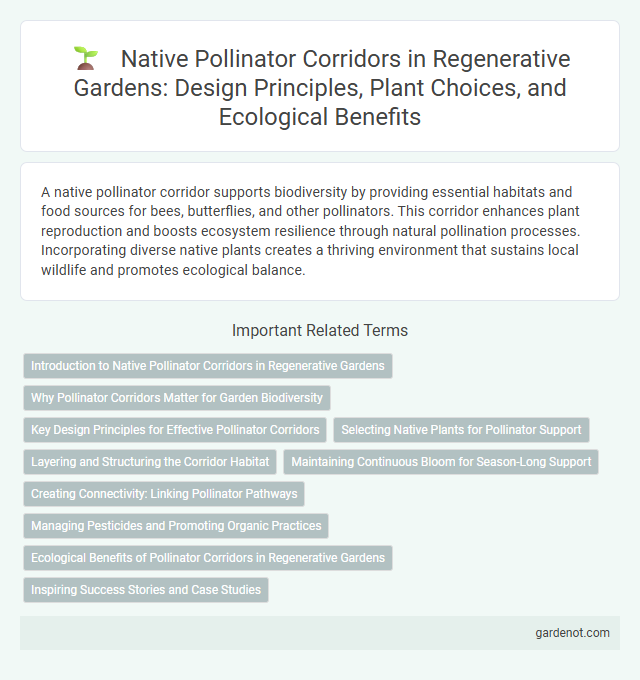A native pollinator corridor supports biodiversity by providing essential habitats and food sources for bees, butterflies, and other pollinators. This corridor enhances plant reproduction and boosts ecosystem resilience through natural pollination processes. Incorporating diverse native plants creates a thriving environment that sustains local wildlife and promotes ecological balance.
Introduction to Native Pollinator Corridors in Regenerative Gardens
Native pollinator corridors in regenerative gardens create critical habitats that support biodiversity by connecting fragmented ecosystems. These corridors enhance the survival of essential pollinators like bees, butterflies, and hummingbirds, promoting natural plant reproduction and ecosystem resilience. Integrating native flowering plants and shrubs tailored to local pollinators maximizes ecological benefits and ensures sustainable garden productivity.
Why Pollinator Corridors Matter for Garden Biodiversity
Pollinator corridors create connected habitats that support diverse native pollinators essential for the reproduction of numerous plants in regenerative gardens. By facilitating pollinator movement, these corridors enhance genetic diversity and resilience within plant communities, promoting ecosystem health. Maintaining native pollinator populations through well-designed corridors increases crop yields and sustains biodiversity by supporting a wide range of flowering species.
Key Design Principles for Effective Pollinator Corridors
Native pollinator corridors thrive through strategic planting of diverse, regionally adapted flowering plants that provide continuous bloom cycles from early spring to late fall. Prioritizing habitat connectivity by linking fragmented green spaces facilitates safe foraging and migration routes for pollinators like bees, butterflies, and hummingbirds. Incorporating nesting sites, avoiding pesticide use, and maintaining structural complexity enhances pollinator health and biodiversity within regenerative garden ecosystems.
Selecting Native Plants for Pollinator Support
Selecting native plants such as milkweed, coneflowers, and goldenrod creates an essential native pollinator corridor that sustains local bee and butterfly populations. These plants provide critical nectar sources and breeding habitats, enhancing biodiversity while promoting resilient ecosystems. Incorporating a diverse mix of flowering periods ensures continuous food availability, supporting pollinator health and regenerative garden success.
Layering and Structuring the Corridor Habitat
Layering and structuring the native pollinator corridor habitat enhances biodiversity by incorporating a diverse range of plants that bloom sequentially throughout the growing season, providing continuous forage for bees, butterflies, and other pollinators. Vertical stratification includes groundcover plants, mid-height flowering shrubs, and taller native trees, creating microhabitats and shelter that support various pollinator species. This multi-layered approach maximizes habitat complexity, promotes pollinator health, and supports ecosystem resilience in regenerative garden designs.
Maintaining Continuous Bloom for Season-Long Support
Maintaining continuous bloom in a native pollinator corridor ensures season-long forage for bees, butterflies, and other vital pollinators, enhancing biodiversity and ecosystem resilience. Planting a diverse mix of native wildflowers, shrubs, and grasses with staggered flowering times supports continuous nectar and pollen availability from early spring through late fall. This strategy boosts pollinator health, promotes effective pollination, and strengthens habitat connectivity in regenerative garden systems.
Creating Connectivity: Linking Pollinator Pathways
Creating connectivity through native pollinator corridors enhances biodiversity by linking fragmented habitats, enabling efficient movement and foraging of native pollinators such as bees, butterflies, and hummingbirds. These corridors support ecosystem resilience by facilitating gene flow and increasing pollination success across various plant species within regenerative gardens. Strategic planting of native flowering plants along these pathways fosters continuous nectar sources, crucial for sustaining pollinator populations throughout their active seasons.
Managing Pesticides and Promoting Organic Practices
Managing pesticides in a native pollinator corridor involves reducing or eliminating synthetic chemicals to protect essential pollinator species such as bees, butterflies, and hummingbirds. Promoting organic practices like using natural pest predators, companion planting, and organic mulches enhances soil health and biodiversity, creating a resilient ecosystem. These strategies ensure the sustainability of pollinator habitats, crucial for plant reproduction and overall garden regeneration.
Ecological Benefits of Pollinator Corridors in Regenerative Gardens
Native pollinator corridors enhance biodiversity by providing crucial habitats and food sources for bees, butterflies, and other pollinators within regenerative gardens. These corridors support ecosystem resilience, improving pollination rates essential for local plant reproduction and food production. The increased pollinator activity contributes to healthier soil structure and natural pest control, promoting sustainable garden productivity.
Inspiring Success Stories and Case Studies
Native pollinator corridors have transformed landscapes by fostering biodiversity and boosting crop yields in regenerative gardens. Case studies from the Midwest reveal a 40% increase in pollination rates after establishing interconnected habitats with native flowering plants. Inspiring success stories highlight communities collaborating to create corridors that support endangered pollinators while enhancing ecosystem resilience.
Native pollinator corridor Infographic

 gardenot.com
gardenot.com